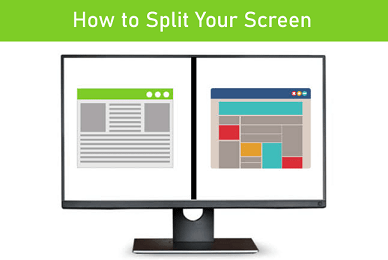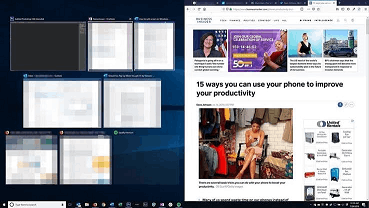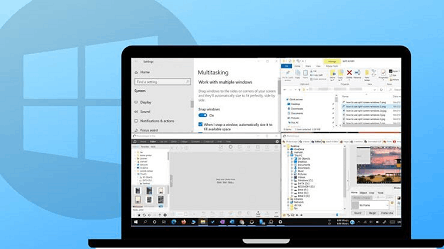How to split a screen in Windows?
Splitting a screen in Windows is a useful feature that allows you to view two or more windows simultaneously. This can help you be more productive by enabling you to work onto the multiple tasks simultaneously at the same time. In this article, we will discuss how to split a screen in Windows with the help of different methods.
There are several ways to split a screen in Windows, depending on your version of Windows and the type of device you are using. Here are some methods you can use:

Method 1: Using Snap Assist
Snap Assist is a feature built into Windows 10 that allows you to snap windows into different areas of the screen. Here's how to use it:
- Open the windows you want to display on the screen.
- Click and hold the title bar of one of the windows.
- Drag the window to the left or right side of the screen until it "snaps" into place.
- Release the mouse button.
- You should see a list of other open windows appear on the opposite side of the screen.
- Click on the window you want to display alongside the snapped window.
- The two windows should now be displayed side by side.
Method 2: Using Windows Key + Arrow Keys
Another way to split the screen in Windows 10 is by using the Windows key + arrow keys. Here's how:
- Open the windows you want to display on the screen.
- Press and hold the Windows key.
- While holding down the Windows key, press either the left or right arrow key.
- The active window will snap to the left or right side of the screen.
- You can then select another window to display on the opposite side of the screen.
Method 3: Using Display Settings
If you have a large monitor, you may want to split the screen into more than two sections. To do this, you can use the Display Settings feature in Windows 10. Here's how:
- Right-click on the desktop and select Display settings.
- Under the "Select and rearrange displays" section, click on the monitor you want to split.
- Scroll to the "Multiple displays" section and select "Extend desktop".
- Drag the monitors to arrange them in the configuration you want.
- Click on the monitor you want to split.
- Under "Multiple displays", select "Show only on this display".
- Open the windows you want to display on the split screen.
- Drag the windows to the edges of the screen to snap them into place.
In conclusion, splitting a screen in Windows can be done using Snap Assist, the Windows key + arrow keys, or Display Settings. These methods are easy to use and can help you be more productive by allowing you to work on multiple tasks simultaneously.

Advantages of Splitting screen in Windows
Splitting a screen in Windows has several advantages, which can improve productivity and efficiency. Here are some of the benefits of splitting a screen:
Multitasking: Splitting the screen allows you to work on multiple tasks simultaneously without switching between windows. This can be particularly helpful when working on the complex projects that requires referencing different documents or applications.
Better organization: With a split screen, you can organize your workspaces more efficiently. For example, you can have one window for email and another for a web browser or a document editor. This can help you stay organized and focused on the task which is most important to done.
Time-saving: Splitting a screen can save you time by eliminating the need to constantly switch between different windows. This can be particularly beneficial when working on tight deadlines or when you need to complete multiple tasks in a short amount of time.
Increased visibility: Splitting the screen allows you to view more content onto the monitor at the same time and saves time. This can be particularly used at the time when working with large spreadsheets, presentations, or documents that require a lot of scrolling at the same time.
Improved collaboration: Splitting the screen can also improve collaboration, as you can share your screen with others and work on the same project together.
In conclusion, splitting the screen in Windows can provide several benefits, including improved multitasking, organization, time-saving, increased visibility, and improved collaboration. By utilizing this feature, you are going to be increase your productivity and efficiency while working on your pc.
Some important information about Splitting screens in Windows
Splitting the screen in Windows is a powerful feature that has become increasingly popular with the rise of remote work and online collaboration. Many more aspects of this topic can be explored, including:
Customization: Windows provides many options for customizing the split-screen view. For example, you can adjust the size of each window, arrange the windows vertically, and snap windows to specific parts of the screen.
Third-party apps: In addition to the built-in Windows features, many third-party apps can help you split the screen. Some of these apps provide additional features like multiple monitor support, customizable keyboard shortcuts, and enhanced window snapping.
Multiple monitors: If you have multiple monitors, then you can split the screen across all of them. This provides even more workspace and allow you to view the multiple applications or documents simultaneously.
Operating systems: While this article focuses on Windows, splitting the screen is also possible on other operating systems, including macOS and Linux. The process may differ slightly depending on the operating system and versions of the window, but the basic principles are similar.
Best practices: While splitting the screen can be a useful tool for productivity, it's important to use it wisely. Some best practices include prioritizing the most important tasks on the primary screen, minimizing distractions, and taking regular breaks to avoid eye strain and fatigue.
Overall, we observe that splitting the screen in Windows is a valuable feature that can help you be more productive and efficient and effective when working on your computer. By exploring the various options and best practices, you can make the most of this tool and improve your work output.
Different uses of splitting the screen in Windows
Splitting the screen in Windows can be used in a variety of ways to improve productivity and workflow. Here are some different uses of splitting the screen:
- Comparison: Splitting the screen is also useful for comparing two documents or applications side-by-side. For instance, you could open two different versions of a document and compare the changes, or you could compare two web pages for differences in content or layout.
- Collaboration: Splitting the screen is a helpful tool for the collaborating with others remotely. By sharing your screen and splitting it, you can work on the same document or application together, which can be particularly useful for team projects.
- Information retrieval: Splitting the screen is helpful for retrieving information from one source and using it in another application. For example, you could have a web browser open on one side of the screen and on the other side a note-taking application on the other. This would allow you to copy and paste information from the web browser into your notes quickly and easily.
- Presentation: Splitting the screen is also useful for presentations. You can have your presentation open on one side of the screen, and your notes or other supporting documents on the other side, which can help you stay on track during your presentation.
- Gaming: Splitting the screen is useful for gaming, especially in multiplayer mode, where players can view their gameplay and communicate with their teammates simultaneously.
Splitting the screen in Windows has many different uses that can improve productivity, workflow, and collaboration. By utilizing this feature effectively, you can improve your productivity and get more done in less time.

Summary
Splitting the screen in Windows is a powerful feature that can improve productivity and efficiency. It has several advantages, including better organization, multitasking, time-saving, increased visibility, and improved collaboration. Splitting the screen allows users to work on multiple tasks simultaneously without switching between different windows. It also allows for better organization and improved visibility by displaying more content on the screen at the same time. Splitting the screen in Windows is customizable, and third-party apps can provide additional features, making it a versatile tool for users. There are various uses for splitting the screen, including multitasking, comparison, collaboration, information retrieval, presentation, and gaming. However, it's essential to use it wisely and prioritize tasks on the primary screen, minimize distractions, and take regular breaks to avoid eye strain and fatigue. Overall, splitting the screen in Windows is a valuable tool that can help users be more productive and efficient while working on their computer.